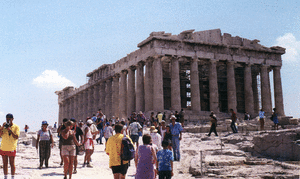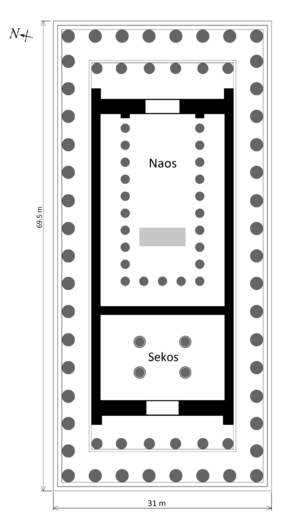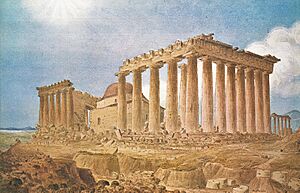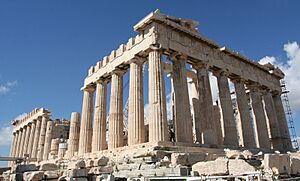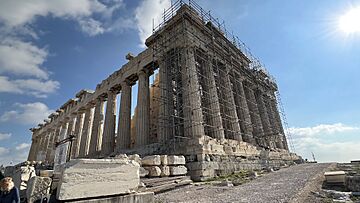Parthenon facts for kids
Quick facts for kids Parthenon |
|
|---|---|
|
Παρθενώνας
|
|

The Parthenon in 1978
|
|
| General information | |
| Type | Temple |
| Architectural style | Classical |
| Location | Athens, Greece |
| Coordinates | 37°58′17″N 23°43′36″E / 37.9715°N 23.7266°E |
| Construction started | 447 BC |
| Completed | 432 BC; 2457 years ago |
| Destroyed | Partially in 1687 |
| Height | 13.72 m (45.0 ft) |
| Dimensions | |
| Other dimensions | Cella: 29.8 by 19.2 m (98 by 63 ft) |
| Technical details | |
| Material | Pentelic Marble |
| Size | 69.5 by 30.9 m (228 by 101 ft) |
| Floor area | 73 by 34 m (240 by 112 ft) |
| Design and construction | |
| Architect | Iktinos, Callicrates |
| Other designers | Phidias (sculptor) |
The Parthenon is an ancient Greek temple located on the Athenian Acropolis in Greece. It was built to honor the goddess Athena, who was seen as the protector of Athens. The beautiful sculptures on the Parthenon are considered some of the best examples of classical Greek art. Today, the Parthenon is a lasting symbol of ancient Greece, democracy, and Western civilization.
This amazing building was constructed in the 5th century BC. It was a way for the Greeks to show thanks for their victory over the Persian invaders during the Greco-Persian Wars. Like many Greek temples, the Parthenon also served as the city's treasury, holding important valuables. Building began in 447 BC when the Delian League (a group of Greek city-states led by Athens) was very powerful. It was mostly finished by 438 BC, but artists continued working on the decorations until 432 BC. For a while, it even held the treasury of the Delian League, which later became the Athenian Empire.
Later, the Parthenon was changed into a Christian church in the late 500s AD, dedicated to the Virgin Mary. After the Ottoman Empire took over in the mid-1400s, it became a mosque. In 1687, during the Morean War, a Venetian bomb hit the Parthenon. The Ottomans were using it to store gunpowder, and the explosion caused a lot of damage. From 1800 to 1803, the 7th Earl of Elgin took many of the remaining sculptures. He shipped them to England, where they are now known as the Elgin Marbles. Since 1975, many large projects have been working to restore and protect the Parthenon.
Contents
What Does "Parthenon" Mean?
The name "Parthenon" comes from the Greek word parthénos, which means "maiden" or "virgin." This name likely refers to the goddess Athena, who was a virgin goddess. Some people believe it might have referred to a special room in the temple where young girls, called arrephoroi, wove a special dress (a peplos) for Athena during the Panathenaic Festivals.
In ancient times, people sometimes called the building Hekatómpedos, which means "the hundred-footer." This name might have been used because of its impressive size or its beautiful design. The name "Parthenon" for the entire building became common later, around the 4th century BC.
What Was the Parthenon Used For?
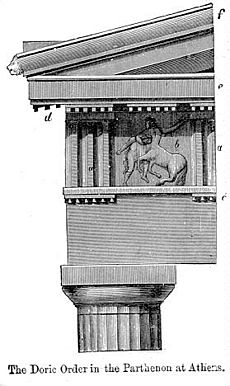
Even though the Parthenon looks like a temple and is often called one, some experts say it wasn't a temple in the usual way. While a small shrine was found inside, the Parthenon didn't host the main religious ceremonies for Athena. The most important statue of Athena, which was bathed in the sea and given a new dress, was in another temple nearby.
The huge statue of Athena inside the Parthenon, made by the famous sculptor Phidias, wasn't used for daily worship. It was more like a grand offering to the goddess. During the Peloponnesian War, the Athenian leader Pericles even said that the gold on the statue could be used if Athens needed money for the war, showing it was also seen as a valuable reserve. Other treasures, like Persian swords, were also stored inside. So, some scholars believe the Parthenon was more of a magnificent display for a huge statue and a treasury, rather than a place for regular religious services.
Building the Parthenon
The Older Parthenon
Before the current Parthenon, there was an earlier attempt to build a sanctuary for Athena on the same spot. This project started around 490–488 BC, after the Battle of Marathon. This older building, sometimes called the "Older Parthenon," was still being built when the Persians attacked Athens in 480 BC and destroyed the Acropolis.
Evidence of this older building was found during excavations in the late 1800s. Parts of its columns were even used in other walls on the Acropolis. After the Persian attack, the site was left in ruins for over 30 years. This might have been because of an oath the Greeks took not to rebuild sanctuaries destroyed by the Persians until a peace treaty was signed. Also, rebuilding Athens after the destruction was a huge and expensive task.
The Present Building
In the mid-5th century BC, when Athens became the leader of the Delian League, Pericles started a massive building project on the Acropolis. The Parthenon, along with other famous buildings like the Propylaia and the Erechtheion, were all built during this time.
Phidias was in charge of the entire project, including the sculptures. The architects Iktinos and Callicrates began their work in 447 BC, and the main structure was mostly finished by 432 BC. The decorations continued until at least 431 BC.
The Parthenon was built mainly by skilled marble workers. These quarrymen were experts at cutting huge blocks of Pentelic Marble to exact measurements. They also knew how to avoid flaws in the marble. If a block wasn't perfect, the architects would reject it. Iron tools like picks, chisels, and drills were used to shape the marble.
This huge project brought stonemasons from all over Greece to Athens. Slaves, foreigners, and Athenian citizens all worked together, doing the same jobs for the same pay. Building temples was a very specialized skill, and these craftsmen would travel wherever their skills were needed. Carpenters, metalworkers, and many unskilled laborers were also essential for moving the heavy marble blocks and completing the Parthenon.
How Was the Parthenon Designed?
The Parthenon is a Doric temple, meaning it has strong, simple columns. It also has some features from the Ionic style. It stands on a platform with three steps. Like other Greek temples, it was built using a "post and lintel" method, where horizontal beams (lintels) rest on vertical columns (posts).
There are eight columns at each end of the temple and seventeen columns along each side. Inside the main colonnade, there's an inner stone structure called the cella, which is divided into two rooms. The back room, called the opisthodomos, held the money from the Delian League. At both ends of the building, the triangular sections above the columns, called pediments, were filled with amazing sculptures.
The Parthenon is considered the best example of the Doric style. Its columns have simple tops (capitals), grooves (flutes) carved into them, and no bases. Above the columns, there's a frieze with carved panels called metopes. These are typical of the Doric style. However, there's also a continuous frieze with carvings in low relief around the inner walls of the cella, which is an Ionic feature. This mix of styles makes the Parthenon unique.
The base of the Parthenon measures about 69.5 meters (228 feet) long and 30.9 meters (101 feet) wide. The outer columns are about 1.9 meters (6.2 feet) wide and 10.4 meters (34 feet) tall. The columns at the corners are slightly wider. In total, the Parthenon had 46 outer columns and 23 inner columns, each with 20 flutes. The roof was covered with large, overlapping marble tiles.
The Parthenon is famous for its "optical refinements." This means the builders made tiny adjustments to make the building look perfectly straight and balanced. For example, the platform it stands on has a slight curve upwards, and the columns have a tiny bulge in the middle, called entasis. These subtle curves make the building appear straight and strong from a distance, preventing it from looking like it sags in the middle. The columns also lean slightly inward, so if they continued upwards, they would meet far above the temple. These clever design choices show the incredible skill of the ancient Greek architects.
Amazing Sculptures
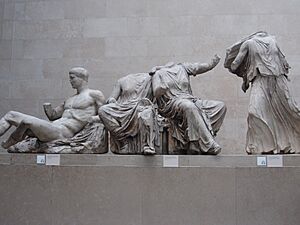
The Parthenon was once home to a huge statue of Athena, made of gold and ivory, sculpted by Phidias. This statue is now lost, but we know what it looked like from copies and descriptions. The decorative stonework on the temple was originally painted in bright colors.
Only a few of the original sculptures are still on the building today. Most of the surviving sculptures are in the Acropolis Museum in Athens and the British Museum in London (these are the famous Elgin Marbles). Other pieces are in museums like the Louvre in Paris. In 2022, the Acropolis Museum launched a website with photos of all the frieze blocks, including those in other museums.
Metopes: Battle Scenes
The Parthenon's outer frieze had 92 carved panels called metopes. These were carved in high relief, meaning the figures stood out a lot from the background. The metopes on the east side, above the main entrance, show the Gigantomachy, a mythical battle between the Olympian gods and the Giants. The west side metopes show the Amazonomachy, a battle between the Athenians and the Amazons. The south side metopes depict the Centauromachy, a battle between the Lapiths and the half-human, half-horse Centaurs. The metopes on the north side, which are not as well preserved, seem to show the sack of Troy.
Many of these mythological figures were damaged by Christians in ancient times, who wanted to remove images of pagan gods. Some metopes are still on the building, but they are very damaged. Others are in the Acropolis Museum and the British Museum. In 2011, archaeologists found five more metopes hidden in a wall of the Acropolis, which had been used to repair the fortress in the 18th century.
Frieze: The Panathenaic Procession
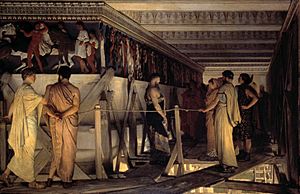
A very special feature of the Parthenon is the Ionic frieze that runs around the outside of the inner cella walls. This frieze, carved in low relief, was created between 443 and 438 BC.
Many people believe it shows an idealized version of the Panathenaic procession. This was a grand parade held every year in Athens, with a special, larger one every four years. Athenians and foreigners would march from the Dipylon Gate to the Acropolis to honor Athena. They would offer sacrifices and a new peplos dress, woven by selected noble Athenian girls. The frieze shows the procession becoming more crowded as it approaches the gods on the eastern side of the temple.
Pediments: Birth and Battle
The two triangular sections, or pediments, above the entrances of the Parthenon once held massive sculptures. According to an ancient writer named Pausanias, the sculptures on the east pediment showed the birth of Athena. The west pediment depicted the mythical contest between Athena and Poseidon to become the patron god of Athens.
East Pediment
The east pediment originally had 10 to 12 sculptures showing the Birth of Athena. Most of these pieces were lost during later renovations. Today, only two corners remain, with figures representing the passage of time throughout a day. The horses of Helios (the sun god) are shown rising into the sky at the start of the day, while Selene's (the moon goddess) horses struggle to stay on the scene as the day ends.
West Pediment
The west pediment showed the contest between Athena and Poseidon. Athena's supporters are shown on the left, and Poseidon's on the right. It's believed that the corners of the pediment were filled with Athenian water gods, like the rivers Kephisos and Ilissos. The statue of Poseidon was the largest sculpture here, but it broke into pieces when people tried to remove it in 1688. What's interesting is that every statue on the west pediment has a fully carved back, even though it would have been impossible to see when the sculpture was on the temple. This shows how much effort the sculptors put into their work.
Athena Parthenos: The Lost Statue
The only sculpture from the Parthenon known to be made by Phidias himself was the huge gold and ivory statue of Athena inside the main room. This statue is now lost, but we know what it looked like from copies, paintings, and ancient descriptions.
Later History of the Parthenon
From Temple to Church
The Parthenon served as a temple dedicated to Athena for nearly 1,000 years. Around the mid-200s AD, a major fire damaged its roof and interior. Later, in 276 AD, Heruli pirates attacked Athens and destroyed many public buildings, including the Parthenon. Repairs were made in the 300s AD.
In the late 400s AD, the Parthenon was changed into a Christian church dedicated to the Virgin Mary. The building's entrance was moved to the west, and the Christian altar was placed in the east. Walls were built between the columns, and Christian images were painted on the walls. These changes meant some of the original sculptures were removed or damaged. The Parthenon became an important Christian pilgrimage site.
From Church to Mosque
In 1456, the Ottoman Turks took control of Athens. Sometime before the late 1400s, the Parthenon was converted into a mosque. The Christian altar was removed, and a minbar (a pulpit in a mosque) was added. The tower that had been built during the Christian period was made taller to become a minaret (a tower from which calls to prayer are made). The walls were whitewashed to cover the Christian paintings.
Even with these changes, the Parthenon's structure remained mostly intact for a long time. In 1667, a Turkish traveler named Evliya Çelebi was amazed by its sculptures and described it as an "impregnable fortress not made by human agency." In 1674, a French artist named Jacques Carrey sketched the Parthenon's sculptures. These drawings are very important because they show what the Parthenon looked like before it was severely damaged.
The Great Explosion
In 1687, during the Morean War, the Venetians attacked Athens. The Ottomans were using the Parthenon as a gunpowder magazine (a place to store gunpowder) and as a shelter. On September 26, 1687, a Venetian mortar shell hit the Parthenon. The explosion was massive, blowing out the central part of the building and causing the walls to crumble.
About three hundred people were killed in the explosion. The roof was destroyed, and many columns fell. The explosion also caused fires that destroyed nearby homes. After the explosion, the Venetians tried to take some of the remaining sculptures, causing even more damage. In 1688, the Venetians left Athens. The Turks then built a smaller mosque inside the ruined Parthenon. For the next 150 years, parts of the damaged structure were taken for building materials.
Modern Era and Restoration
In the 18th century, more Europeans visited Athens, and the ruins of the Parthenon became very popular. This helped create sympathy in Britain and France for Greek independence. In the early 1800s, agents of Thomas Bruce, 7th Earl of Elgin removed about half of the remaining Parthenon sculptures and sent them to Britain. The legality of his actions is still debated today.
During the Greek War of Independence (1821–1833), the Acropolis was attacked twice. The Parthenon was damaged by Ottoman artillery fire during the second siege. When Greece became independent in 1832, the minaret on the Parthenon was taken down. Soon, all the medieval and Ottoman buildings on the Acropolis were removed, and the area became a historical site controlled by the Greek government.
Today, the Parthenon attracts millions of tourists every year. It is surrounded by a low fence to protect it from damage.
Dispute Over the Marbles
A major disagreement exists over the Parthenon Marbles that were removed by Elgin and are now in the British Museum. Some sculptures are also in the Louvre in Paris and other museums, while more than half are in the Acropolis Museum in Athens. A few pieces are still on the Parthenon itself.
In 1983, the Greek government officially asked the UK government to return the sculptures in the British Museum to Greece. The British Museum has always refused to return them, and British governments have not forced the museum to do so. In 2021, UNESCO asked the UK government to try and solve this issue with Greece. Discussions between UK and Greek officials are still happening. So far, four pieces of the sculptures have been returned to Greece: three from the Vatican and one from a museum in Sicily.
Restoration Efforts
In 1981, an earthquake caused damage to the east side of the Parthenon. Air pollution and acid rain have also harmed the marble and stonework over time.
An organized effort to preserve and restore the buildings on the Acropolis began in 1975. The Greek government created a committee to oversee this work. This project has received funding and help from the European Union. Archaeologists have carefully documented every piece of the site, and architects use computer models to figure out where each piece originally belonged. Important and fragile sculptures have been moved to the Acropolis Museum for safekeeping.
A special crane was installed to move the marble blocks. This crane can fold away when not in use. In some cases, earlier repairs were found to be incorrect, so they were carefully taken apart, and a new restoration process began.
Originally, the marble blocks were held together by iron pins coated in lead, which protected the iron from rust. However, some pins added in the 1800s were not coated and rusted. When iron rusts, it expands, which caused more damage by cracking the marble.
The last remaining slabs from the western part of the Parthenon frieze were removed in 1993 to prevent further damage. They are now in the new Acropolis Museum. Cleaning of the remaining sculptures was completed in 2005. Between 2008, thousands of artifacts, including sculptures and inscriptions, were moved from the old museum on the Acropolis to the new, modern Acropolis Museum.
In 2019, Greece approved a plan to restore parts of the inner cella walls. This project will put back as many as 360 ancient stones and add 90 new pieces of Pentelic marble, using as little new material as possible. The goal is to partially restore some or most of each inner wall.
See also
 In Spanish: Partenón para niños
In Spanish: Partenón para niños
- Ancient Greek architecture
- List of Ancient Greek temples
- National Monument of Scotland, Edinburgh
- Parthenon, Nashville – Full-scale replica
- Temple of Hephaestus


